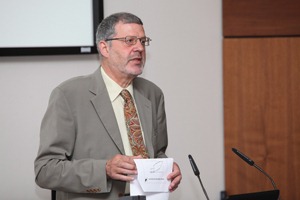Taking an economic approach
 ESRI economist Paul Gorecki tells Meadhbh Monahan about the options open to the Government when considering the future of state assets.
ESRI economist Paul Gorecki tells Meadhbh Monahan about the options open to the Government when considering the future of state assets.
There are three approaches that can be used in order to determine what assets should be sold to reach the €2 billion target, Gorecki began.
Addressing an eolas seminar on state assets, he advocated the use of an economic approach which examines the rationale for public ownership, thereby identifying strategic assets, and which is consistent with the McCarthy report on state assets.
The first approach, revenue maximisation, would involve advisers being hired to value the assets. The assets would then be ranked highest to lowest in value and sold off to generate €2 billion.
Its main advantage is that it is straightforward. However, Gorecki points out that the approach doesn’t distinguish between strategic and non-strategic assets; it would mean selling monopolies and it assumes that ownership is irrelevant “but it’s not.”
“You can try and get as much money as you can by selling monopolies but that has certain disadvantages such as selling strategic assets and [not] setting up the right regulatory environment,” Gorecki told eolas.
The second approach is selling a minority share, which the Government has decided to undertake with ESB.
Again, this is straightforward, Gorecki noted. And, “there is no need to distinguish between strategic and non-strategic assets because the asset is still majority owned by the state.”
On the other hand, it creates a “dysfunctional” corporate governance structure, Gorecki contends, because there are three different shareholders:
• the state “which may have certain things it wants to do such as investment in jobs”;
• the employee and share ownership (ESOP) “which has the interests of employees, both past and present, in mind and is interested in higher wages and good working conditions”; and
• the private entrepreneurs who purchase the minority share who are “presumably … interested in getting maximum profits, which might mean reorganising the company or trying to get lower wages.”
He argued that the minority share approach “doesn’t realise the maximum value” because it assumes that the current state ownership is optimal.
“If you sell the asset at 100 per cent you might get €100 billion. If you sell it at
30 per cent, you will get €30 billion. The person who buys it at €100 billion can set out what they want to do with it e.g. introducing reforms, changing its configuration and realising value for that.
“If on the other hand you can only secure a third of the asset, you don’t have that sort of power, therefore it’s giving you less value than if you sold the whole asset,” he clarified.
In addition, a rationale that justified state ownership 20 to 30 years ago may not be relevant anymore, but that is not taken into account. Therefore, there is “a danger of crystallising the asset and making it difficult to reform.”
The third option, which Gorecki advocates, is the economic approach. It begins by asking: “What is the rationale for state ownership?”
These are:
• market power (the ability to alter the market price of a good or service);
• externalities (such as transmission or telecommunications systems which are of vital importance to the state, and which cannot be allowed to fail for fear of reputational and economic damage); and
• public goods (such as energy supply, clean air or public broadcasting which are not usually supplied by the market.)
The second question is whether that rationale is still relevant today.
Gorecki uses Bord na Móna as an example. Originally it was seen as providing security of supply through its peat mining and power generation operations.
“But that is not tenable today when the focus is on clean air and it is recognised that peat burning plants are quite polluting [therefore] have to pay a higher amount for carbon burners,” Gorecki stated.
He added that electricity prices are more expensive due to the subsidy paid for Bord na Móna’s activities.
“At the moment you could argue that security of supply is [being catered for] through the East West interconnector and Corrib gas is coming on stream. You could [also] argue that, in relation to Bord na Móna, security of supply is no longer relevant,” he claimed.
Government intervention
 An economic approach is the best option when there is a natural monopoly, such as with the electricity and gas transmission networks, or when there is a security of supply issue, as with ownership of the electricity interconnector to Great Britain, according to Gorecki.
An economic approach is the best option when there is a natural monopoly, such as with the electricity and gas transmission networks, or when there is a security of supply issue, as with ownership of the electricity interconnector to Great Britain, according to Gorecki.
The third question asked by the economic approach is whether there are more cost effective policy instruments that could be used to attain the objectives gained from public ownership. Gorecki believes there are.
“The Government has many ways in which it can intervene: regulation, competition policy, tendering,” he said.
However, “up until now regulatory options to deal with problems in certain sectors haven’t been forthcoming in the regulatory regimes that have been created.”
Monopoly companies operating critical infrastructures cannot be allowed to fail and this can be a problem when the company in question is in private ownership. In order to ensure effective regulation when the state-owned firm is privatised, Gorecki suggested that the regulator be allowed to step in, run the firm and dispose of the assets as it sees fit, if the regulated entity fails to meet the conditions set out in its license.
“If you highly leverage a company, you can’t then go to the regulator and ask for an increase in your rates because you can’t fund yourself. If you have a step-in mechanism, the regulator won’t be under as much pressure.
“Also, if you want the firm to do certain things such as rolling out broadband, you issue a licence to it and if it doesn’t fulfil its commitment, that licence taken away and the company is taken over,” Gorecki told eolas.
He claimed that adequate regulatory arrangements need to be in place in advance of any ownership changes.
Gorecki concludes that the economic approach is best because it identifies strategic assets by questioning the relevance of the rationale for public ownership and assesses which objectives are best met by retaining public ownership. It is also consistent with the McCarthy report and with the terms of the EU-IMF bail-out terms and conditions.
He is critical of the Government’s first announcement i.e. that it will sell a minority share of ESB.
“The McCarthy report makes a different set of recommendations in relation to ESB suggesting that some of the generation should be sold off, the transmission should remain within the public sector and the international and other aspects should be sold off as a group.
“It doesn’t recommend that an integrated utility should be sold off with just a minority share,” Gorecki stated. “The [Government’s] first major announcement is completely different than the report.”
He wants to know why the Government made that decision, concluding: “At the moment we don’t have any idea as to why the McCarthy report has been largely thrown aside.”
In response, a spokesman from the Department of Communications, Energy and Natural Resources said that “it should be noted that the McCarthy Report is not government policy although it does, of course, help inform government policy.”
He told eolas that the Government included the McCarthy report’s recommendations in its deliberations on the sale of state assets. “Having considered all the options, the Government decided that, as an initial demonstration of its intent, it would be prepared to sell a minority stake in the ESB as an integrated utility,” the spokesman added. “After careful consideration the Government also decided that the balance of benefit lay with keeping the ESB as a single unit.”





